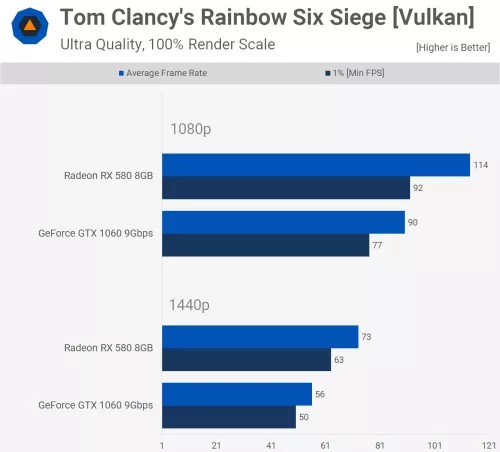The RX 580 compares to the GTX 1060, offering similar performance in many titles, though the RX 580 often excels in newer games utilizing modern APIs like DX12 and Vulkan. This comprehensive comparison delves into the nuances of these graphics cards and their alternatives, empowering you to make informed decisions with COMPARE.EDU.VN. Consider factors like VRAM, game preference, and budget to choose the best graphics card for your needs.
1. Understanding the RX 580 and Its Market Position
The AMD Radeon RX 580, initially released as a refresh of the RX 480, aimed to deliver impressive performance at a competitive price point. This section explores its specifications, target audience, and how it fits into the broader landscape of graphics cards.
1.1. RX 580 Specifications and Architecture
The RX 580 is built on AMD’s Polaris architecture, featuring 2304 stream processors, a boost clock of around 1340 MHz, and typically 8GB of GDDR5 memory. The card’s architecture is designed to handle modern gaming workloads efficiently.
1.2. Target Audience and Use Cases
Designed for mainstream gamers, the RX 580 targets those seeking a balance between performance and affordability. Its capabilities make it suitable for 1080p gaming at high settings and even 1440p gaming in less demanding titles.
1.3. Market Context and Pricing
Initially priced competitively against the GTX 1060, the RX 580 has seen price fluctuations over time. As of now, it often represents excellent value in the budget to mid-range market segment.
2. Head-to-Head: RX 580 vs. GTX 1060
The primary competitor to the RX 580 was the NVIDIA GeForce GTX 1060. This section compares the two cards across various benchmarks, game performance, and features.
2.1. Synthetic Benchmarks
Synthetic benchmarks like 3DMark offer a controlled environment for assessing GPU performance. While results vary, the RX 580 and GTX 1060 generally perform within a similar range, with slight leads depending on the specific test.
2.2. Gaming Benchmarks: A Deep Dive
Game performance is crucial for real-world usage. Here’s a breakdown of how the RX 580 and GTX 1060 compare in popular titles:
2.2.1. Modern Titles with DX12 and Vulkan
In games optimized for modern APIs like DirectX 12 and Vulkan, the RX 580 often exhibits a performance advantage. Examples include “Rainbow Six Siege,” “World War Z,” and “Resident Evil 2.”
2.2.2. Titles Optimized for NVIDIA
Games optimized for NVIDIA, such as “PlayerUnknown’s Battlegrounds (PUBG),” tend to favor the GTX 1060, showcasing NVIDIA’s strong driver support and optimizations for these titles.
2.2.3. Memory-Intensive Games
Titles that demand more VRAM, like “Red Dead Redemption 2” at higher settings, often see the RX 580 (with its typically 8GB VRAM) outperform the GTX 1060 (often with 6GB VRAM), reducing stuttering and improving overall smoothness.
2.3. Performance Consistency Over Time
The RX 580 has generally aged well, thanks to continued driver support and its strong performance in titles using modern APIs. This section examines how each card has held up over the years.
2.4. Power Consumption and Thermals
The GTX 1060 is generally more power-efficient than the RX 580, leading to lower temperatures and quieter operation in many AIB (Add-in-Board) models. This can be a significant factor for users concerned about energy costs and system noise.
3. Alternative Graphics Cards to Consider
While the RX 580 and GTX 1060 were direct competitors, several other graphics cards offer similar or better performance, especially in today’s market. This section explores these alternatives.
3.1. NVIDIA GeForce GTX 1650 Super
The GTX 1650 Super provides comparable performance to the RX 580 with better power efficiency. It’s an excellent choice for those seeking a modern, budget-friendly card.
3.2. NVIDIA GeForce GTX 1660 Super
For a step up in performance, the GTX 1660 Super offers approximately 30% more speed than the RX 580, making it suitable for 1080p gaming at higher refresh rates or 1440p gaming at medium to high settings.
3.3. NVIDIA GeForce RTX 2060
The RTX 2060 offers a significant performance boost over the RX 580, with around 50% more speed. Additionally, it supports ray tracing and DLSS, making it a strong choice for future-proofing.
3.4. AMD Radeon RX 5500 XT
The RX 5500 XT is a newer AMD card that competes with the RX 580 and GTX 1650 Super. It offers a balance of performance and modern features.
4. Factors Influencing Your Choice
Selecting the right graphics card depends on several factors. This section provides a comprehensive guide to help you make the best decision.
4.1. Budget Constraints
Your budget is a primary determinant. The RX 580 often represents excellent value, especially in the used market. However, newer cards like the GTX 1650 Super may offer better long-term value due to efficiency and support.
4.2. Gaming Preferences and Resolution
Consider the types of games you play and your target resolution. For 1080p gaming, the RX 580, GTX 1650 Super, and GTX 1060 are viable options. For 1440p gaming, consider the GTX 1660 Super or RTX 2060.
4.3. Future-Proofing Considerations
If you plan to keep your graphics card for several years, investing in a newer model with more VRAM and support for modern features like ray tracing may be worthwhile.
4.4. Power Supply and System Compatibility
Ensure your power supply can handle the power requirements of the graphics card. The GTX 1060 and GTX 1650 Super are more power-efficient, while the RX 580 and RTX 2060 require more robust power supplies.
5. The Long-Term Perspective
Looking back at the RX 580 and GTX 1060, it’s clear that both cards have served gamers well. This section reflects on their impact and what current owners should consider.
5.1. Reflections on the RX 580 and GTX 1060 Era
Both the RX 580 and GTX 1060 provided excellent gaming experiences for their time, shaping the mid-range market and pushing the boundaries of performance.
5.2. Upgrade Paths for Current Owners
If you currently own an RX 580 or GTX 1060 and are looking to upgrade, consider the GTX 1660 Super, RTX 2060, or newer AMD offerings like the RX 5600 XT, depending on your budget and performance goals.
5.3. The Resale Market
The resale market can be a great place to find deals on RX 580 and GTX 1060 cards. However, be cautious and ensure the card is in good working condition before purchasing.
6. Real-World Scenarios and User Experiences
Beyond benchmarks, real-world user experiences provide valuable insights. This section delves into how users have utilized these cards in various scenarios.
6.1. Gaming at 1080p and 1440p
Users report that the RX 580 and GTX 1060 are well-suited for 1080p gaming, delivering smooth frame rates in most titles. While 1440p gaming is possible, settings may need to be adjusted for optimal performance.
6.2. VR Gaming Capabilities
Both the RX 580 and GTX 1060 are capable of VR gaming, though more demanding titles may require lower settings.
6.3. Content Creation and Productivity
While primarily gaming cards, the RX 580 and GTX 1060 can also handle content creation tasks like video editing and graphic design. However, more powerful cards are recommended for professional workloads.
7. Detailed Game-by-Game Analysis
This section provides a more granular look at game performance, offering insights into specific titles and settings.
7.1. AAA Titles: Performance Breakdowns
Analyzing performance in demanding AAA titles like “Cyberpunk 2077,” “Assassin’s Creed Valhalla,” and “Red Dead Redemption 2” reveals the strengths and weaknesses of each card.
7.2. Esports Titles: High Refresh Rate Gaming
In esports titles like “Counter-Strike: Global Offensive,” “Valorant,” and “Overwatch,” both cards can deliver high frame rates, making them suitable for high refresh rate gaming.
7.3. Indie Games: Performance Considerations
Indie games often have lower hardware requirements, allowing the RX 580 and GTX 1060 to shine.
8. Optimizing Performance: Tips and Tricks
Regardless of which card you choose, optimizing performance can enhance your gaming experience. This section provides practical tips and tricks.
8.1. Driver Updates and Software Optimization
Keeping your drivers updated is crucial for performance and stability. NVIDIA and AMD regularly release new drivers that can significantly improve performance in certain games.
8.2. Overclocking and Undervolting
Overclocking can squeeze extra performance out of your graphics card, while undervolting can reduce power consumption and temperatures. However, proceed with caution and research to avoid damaging your hardware.
8.3. Graphics Settings and Resolution Scaling
Adjusting graphics settings and using resolution scaling techniques like AMD’s FidelityFX Super Resolution (FSR) or NVIDIA’s DLSS can improve performance without sacrificing too much visual quality.
9. Analyzing Power Efficiency and Value
Power efficiency and overall value are crucial considerations. This section examines the power consumption of each card and their value proposition.
9.1. Power Consumption Benchmarks
The GTX 1060 is generally more power-efficient than the RX 580. This can translate to lower electricity bills and reduced heat output.
9.2. Value for Money Analysis
Considering the performance, features, and price, the RX 580 often represents excellent value, particularly in the used market.
9.3. Long-Term Cost Considerations
Factor in the cost of electricity and potential upgrades when assessing the long-term cost of each graphics card.
10. Future Trends in Graphics Card Technology
The graphics card market is constantly evolving. This section looks at upcoming technologies and trends.
10.1. Ray Tracing and DLSS
Ray tracing and DLSS are transforming the gaming landscape, offering more realistic visuals and improved performance.
10.2. Advancements in Memory Technology
New memory technologies like GDDR6 and HBM2E are increasing memory bandwidth and improving overall performance.
10.3. The Impact of New Architectures
New GPU architectures from NVIDIA and AMD continue to push the boundaries of performance and efficiency.
11. Frequently Asked Questions (FAQ)
Q: Is the RX 580 still a good card in 2024?
A: Yes, the RX 580 remains a viable option for 1080p gaming, especially for budget-conscious gamers.
Q: Can the RX 580 run modern AAA games?
A: Yes, but you may need to lower the settings to achieve smooth frame rates in demanding titles.
Q: How does the RX 580 compare to the GTX 1650 Super?
A: The GTX 1650 Super offers similar performance with better power efficiency.
Q: What power supply do I need for the RX 580?
A: A 500W power supply is generally recommended for the RX 580.
Q: Does the RX 580 support ray tracing?
A: No, the RX 580 does not support ray tracing.
Q: What are the advantages of the RX 580 over the GTX 1060?
A: The RX 580 often performs better in games using modern APIs like DX12 and Vulkan and typically has more VRAM.
Q: Is the GTX 1060 better than the RX 580 for VR gaming?
A: Both cards are capable of VR gaming, but performance may vary depending on the title.
Q: Can I overclock the RX 580?
A: Yes, you can overclock the RX 580, but proceed with caution.
Q: What is the typical lifespan of the RX 580?
A: With proper care, the RX 580 can last for several years.
Q: Where can I find the best deals on the RX 580?
A: Check online retailers, used markets, and local computer stores for the best deals.
12. Conclusion: Making the Right Choice
Choosing the right graphics card depends on your individual needs and preferences. By considering factors like budget, gaming preferences, and future-proofing, you can make an informed decision. The RX 580 compares favorably to other cards in its class, and with careful consideration, you can select the best option for your gaming setup.
Navigating the world of graphics card comparisons can be overwhelming, but COMPARE.EDU.VN is here to help. Visit our site at COMPARE.EDU.VN, located at 333 Comparison Plaza, Choice City, CA 90210, United States, or contact us via Whatsapp at +1 (626) 555-9090 for more detailed comparisons and personalized recommendations. Our comprehensive comparisons provide the objective information you need to make confident decisions. Let compare.edu.vn be your guide to informed choices and optimal performance.

